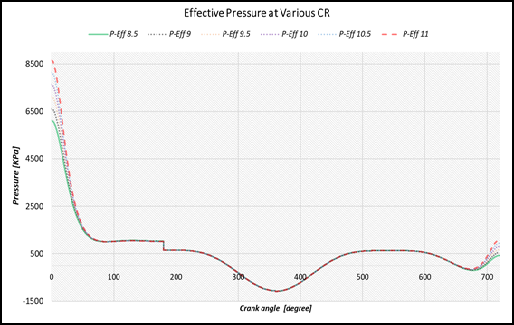Main Article Content
Abstract
The proper design of the flywheel undeniably determines in tuning the engine to confirm the better output engine performance. The aim of this study is to mathematically investigate the effect of various values of the compression ratio on some essential parameters to determine the appropriate value for the flywheel dimension. A numerical calculation approach was proposed to eventually determine the dimension of the engine flywheel on a five-cylinder four-stroke Spark Ignition (SI) engine. The various compression ratios of 8.5, 9, 9.5, 10, 10.5, and 11 were selected to perform the calculations. The effects of compression ratio on effective pressure, indicated mean effective pressure (IMEP), dynamic irregularity value of the crankshaft, and the diameter of the flywheel was clearly investigated. The study found that 2.5 increment value of the compression ratio significantly increases the effective pressure of about 41.53% on the starting of the expansion stroke. While at the end of the compression stroke, the rise of effective pressure is about 76.67%, and the changes in dynamic irregularity merely increase by about 1.79%. The same trend applies to the flywheel diameter and width, which increases 2.08% for both.
Keywords
Article Details

This work is licensed under a Creative Commons Attribution-NonCommercial 4.0 International License.
References
- R. S. Khurmi and J. K. Gupta, A Textbook of Machine Design, First Edit. New Delhi: Eurasia Publishing House LTD, 2004.
- R. Thomas, M. Sreesankaran, J. Jaidi, D. M. Paul, and P. Manjunath, “Experimental evaluation of the effect of compression ratio on performance and emission of SI engine fuelled with gasoline and n-butanol blend at different loads,” Perspect. Sci., 2016, doi: 10.1016/j.pisc.2016.06.076.
- F. Hadia, S. Wadhah, H. Ammar, and O. Ahmed, “Investigation of combined effects of compression ratio and steam injection on performance, combustion and emissions characteristics of HCCI engine,” Case Stud. Therm. Eng., 2017, doi: 10.1016/j.csite.2017.07.005.
- J. Bu, M. Zhou, X. Lan, and K. Lv, “Design characteristic and method of the flywheel motor of cihfape used in helicopter,” in ASME 2017 Internal Combustion Engine Division Fall Technical Conference, ICEF 2017, 2017, doi: 10.1115/ICEF20173543.
- Y. Qiu and S. Jiang, “Dynamics of Flywheel Energy Storage System with Permanent Magnetic Bearing and Spiral Groove Bearing,” J. Dyn. Syst. Meas. Control. Trans. ASME, 2018, doi: 10.1115/1.4037297.
- P. Hassanpour, M. Weaser, R. Colquhoun, K. Alghemlas, and A. Alrashdan, “Experimental determination of the mass moment of inertia of a flywheel using dynamics and statistical methods,” in ASME International Mechanical Engineering Congress and Exposition, Proceedings (IMECE), 2015, doi: 10.1115/IMECE2015-53557.
- J. F. Dunne and L. A. Ponce Cuspinera, “Optimal gear ratio planning for flywheel-based kinetic energy recovery systems in motor vehicles,” J. Dyn. Syst. Meas. Control. Trans. ASME, 2015, doi: 10.1115/1.4029929.
- J. Sevik et al., “Influence of charge motion and compression ratio on the performance of a combustion concept employing in-cylinder gasoline and natural gas blending,” J. Eng. Gas Turbines Power, 2018, doi: 10.1115/1.4040090.
- V. Hariram and R. Vagesh Shangar, “Influence of compression ratio on combustion and performance characteristics of direct injection compression ignition engine,” Alexandria Eng. J., 2015, doi: 10.1016/j.aej.2015.06.007.
- L. Chen, W. K. Shi, and Z. Y. Chen, “Modeling and Experimental Study on Dynamic Characteristics of Dual-Mass Flywheel Torsional Damper,” Shock Vib., 2019, doi: 10.1155/2019/5808279.
- D. V. Berezhnoi, L. R. Gajnulina, and A. A. Sachenkov, “Investigation of stress-strain state in the flywheel and estimation their specific energy capacity,” MATEC Web Conf., vol. 129, pp. 1–4, 2017, doi: 10.1051/matecconf/201712906027.
- Y. Ren and J. Fang, “Modified cross feedback control for a magnetically suspended flywheel rotor with significant gyroscopic effects,” Math. Probl. Eng., 2014, doi: 10.1155/2014/325913.
- L. Chen, R. Zeng, and Z. Jiang, “Nonlinear dynamical model of an automotive dual mass flywheel,” Adv. Mech. Eng., 2015, doi: 10.1177/1687814015589533.
- M. Andriollo, R. Benato, and A. Tortella, “Design and modeling of an integrated flywheel magnetic suspension for kinetic energy storage systems,” Energies, 2020, doi: 10.3390/en13040847.
- A. Yudianto, N. Kurniadi, I. Wayan Adiyasa, and Z. Arifin, “The Effect of Masses in the Determination of Optimal Suspension Damping Coefficient,” in Journal of Physics: Conference Series, 2019, vol. 1273, no. 1, doi: 10.1088/1742-6596/1273/1/012067.
- A. Mittica and S. Ambrosio, “Combustion Engines and Their Application to Vehicles - Lecture notes,” in Combustion Engines and Their Application to Vehicles, Torino: Politecnico di Torino, 2018.
- J. Heywood, Internal Combustion Engine Fundamentals. McGraw-Hill, 1998.
- F. K. Ma et al., “Parameter optimization on the uniflow scavenging system of an OP2S-GDI engine based on indicated mean effective pressure (IMEP),” Energies, 2017, doi: 10.3390/en10030368.
- M. Cocconcelli et al., “Numerical and Experimental Dynamic Analysis of IC Engine Test Beds Equipped with Highly Flexible Couplings,” Shock Vib., 2017, doi: 10.1155/2017/5802702.
- G. M. Kosmadakis and C. D. Rakopoulos, “A fast CFD-based methodology for determining the cyclic variability and its effects on performance and emissions of spark-ignition engines,” Energies, 2019, doi: 10.3390/en12214131.
- J. Hunicz, “On cyclic variability in a residual effected HCCI engine with direct gasoline injection during negative valve overlap,” Math. Probl. Eng., 2014, doi: 10.1155/2014/359230.
- O. I. Awad, Z. Zhang, M. Kamil, X. Ma, O. M. Ali, and S. Shuai, “Wavelet analysis of the effect of injection strategies on cycle to cycle variation GDI optical engine under clean and fouled injector,” Processes, 2019, doi: 10.3390/pr7110817.

